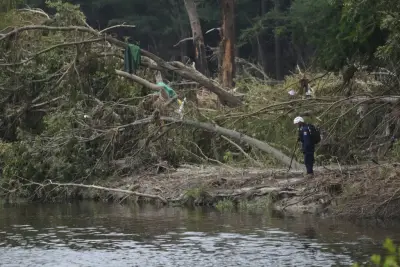Emergency crews suspend search for flooding victims in central Texas amid new flood warnings

KERRVILLE, Texas (AP) — Emergency crews suspended their search for victims of catastrophic flooding in central Texas on Sunday morning amid new warnings that additional rain would again cause waterways to surge. It was the first time a new round of severe weather has paused the search since the flooding earlier this month. Ingram Fire Department officials ordered search crews to immediately evacuate the Guadalupe River corridor in Kerr County until further notice, warning the potential for a flash flood is high. Search-and-rescue teams have been searching for missing victims of the July 4 weekend flooding. Search and rescue efforts were expected to resume on Monday, depending on river flow, Fire Department spokesman Brian Lochte said. “We’re working with a few crews and airboats and SAR (search-and-rescue) boats just in case,” Lochte said. As heavy rain fell Sunday, National Weather Service forecasters warned that the Guadalupe River could rise to nearly 15 feet (4.6 meters) by Sunday afternoon, about five feet above flood stage and enough to put the Highway 39 bridge near Hunt under water. “Numerous secondary roads and bridges are flooded and very dangerous,” a weather service warning said. The destructive, fast-moving waters rose 26 feet (8 meters) on the Guadalupe River in just 45 minutes before daybreak on July 4, washing away homes and vehicles. Ever since, searchers have used helicopters, boats and drones to look for victims and to rescue people stranded in trees and from camps isolated by washed-out roads. The floods laid waste to the Hill Country region of Texas. The riverbanks and hills of Kerr County are filled with vacation cabins, youth camps and campgrounds, including Camp Mystic, the century-old all-girls Christian summer camp. Located in a low-lying area along the Guadalupe River in a region known as flash flood alley, Camp Mystic lost at least 27 campers and counselors and longtime owner Dick Eastland. The flood was far more severe than the 100-year event envisioned by the Federal Emergency Management Agency, experts said, and moved so quickly in the middle of the night that it caught many off guard in a county that lacked a warning system. The sheer amount of rain was overwhelming. Former NOAA chief scientist Ryan Maue, a private meteorologist, calculated on July 5 that the storm had dropped 120 billion gallons of water on Kerr County, which received the brunt of the storm. This summer, flash flooding driven by bursts of heavy rain turned deadly elsewhere in Texas. In San Antonio in June, more than 7 inches (18 centimeters) of rain fell over a span of hours, prompting dozens of rescues from the fast-rising floodwaters and killing at least 13. Source

